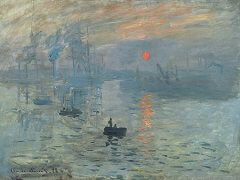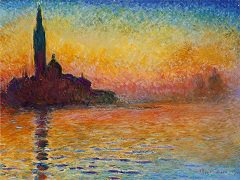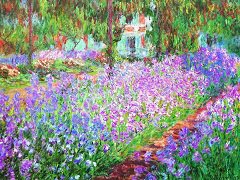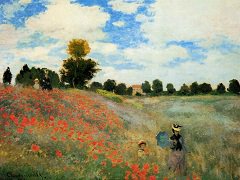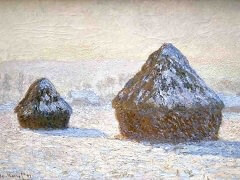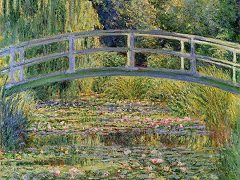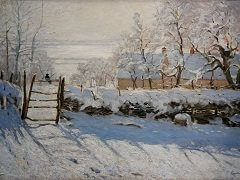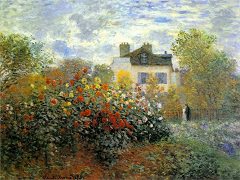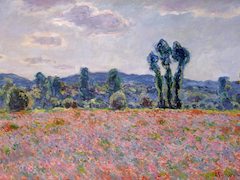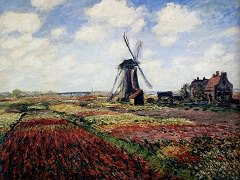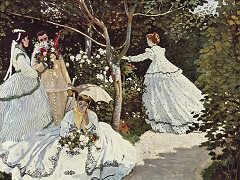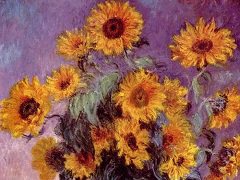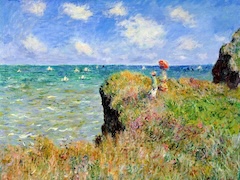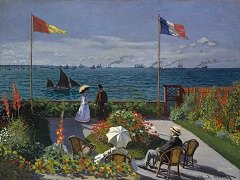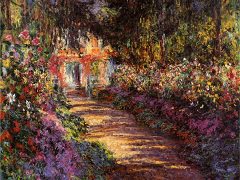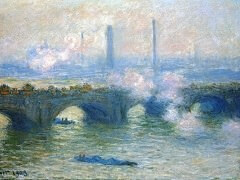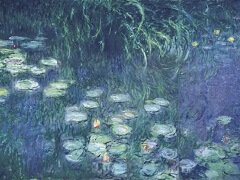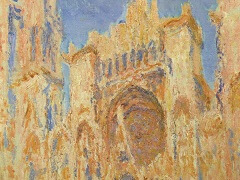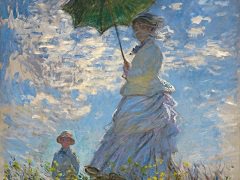Monet & Gauguin: Impressionist & Post-Impressionist
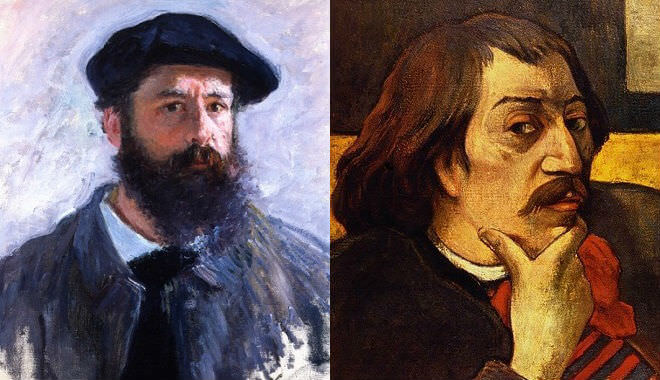
When compared, Claude Monet's Camille Monet on a Garden Bench and Paul Gauguin's The Siesta, exhibit innovative aesthetic characteristics which position both works firmly within the discourse of 'modern' Western painting. Monet and Gauguin's loose application of paint, deemphasis on local coloring and rejection of strict chiaroscuro, modeling and tonal gradations distance these artists from the refined Renaissance and Baroque aesthetics of Da Vinci, El Greco, and Caravaggio. Such radical techniques signaled a shift in the treatment of the artistic work, transforming the nature of the canvas from a metaphorical window onto another reality, into an object that the viewer looks at rather than through. The stressing of the canvas' flatness, a self-critical tendency identified by 20th century critic Clement Greenberg which, for him, detached painting's modern era from the influence of the Old Masters, is emphasized within both Camille Monet on a Garden Bench and The Siesta, particularly through the refutation of sculptural shading and formalized composition. Furthermore, Monet and Gauguin's secular subjects and 'natural' settings, a far cry from the religious idealizations of the Renaissance, reflect, on one hand, the increasing secularization of socio-economic Europe, principally made manifest in the visual arts by the non-spiritual, Realist tradition championed by Courbet and Daumier and, on the other, the reemerging influence of the European Romantic tradition.

While Monet's Camille Monet on a Garden Bench is a pristine example of Impressionism, a movement conceived during the 19th century which visually interpreted the interplay of light and color, it would be disingenuous to describe the aesthetic of The Siesta similarly. While Gauguin originally emulated the impressionist style of Camille Pissarro in works such as Landscape at Viroflay, The Siesta signifies a radical rejection of Monet's systematic Impressionism in the handling of subject, line, depth and, most explicitly, color. Critics have come to define Gauguin's style as 'Post-Impressionist,' a general term for those artists, like Gauguin, Van Gogh, Paul Cezanne and Seurat, who reinterpreted, both expressively and analytically, established impressionist considerations. As such, through the articulation and comparison of their primary characteristics, particularly the stated aims/ends of their respective aesthetics, the nature of their subject matter, the selection and treatment of color, and the handling of shape, depth and contour, Camille Monet on a Garden Bench and The Siesta reveal themselves as part of two distinct, separate, yet interrelated movements, Impressionism and Post-Impressionism, respectively.
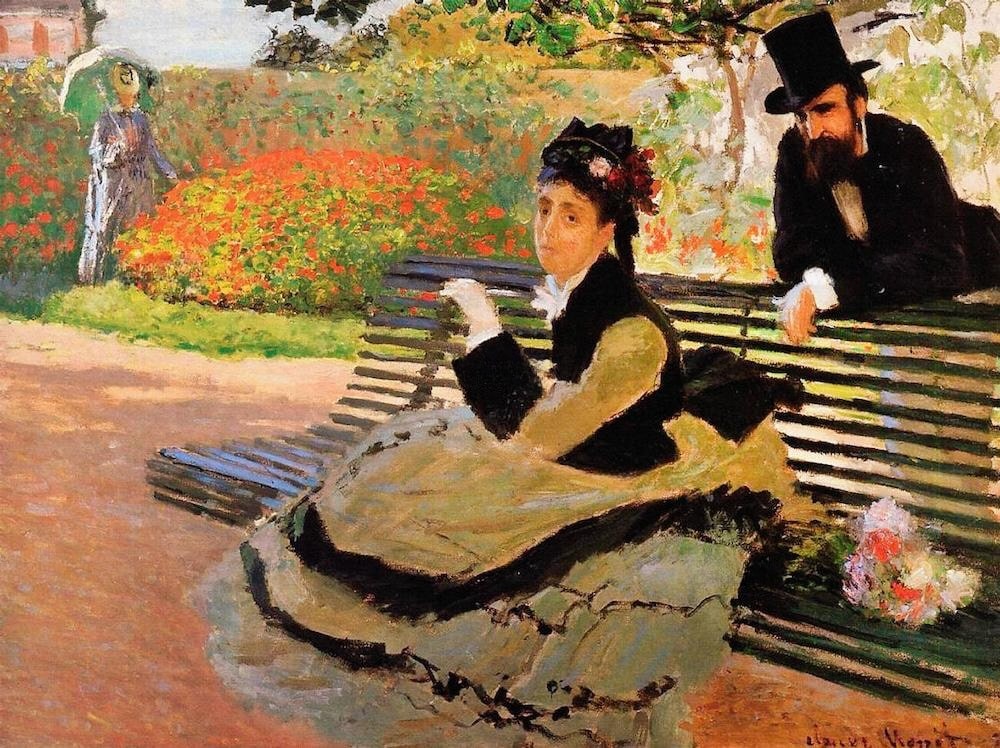
For many, Monet's name is synonymous with Impressionism; his paintings, like Impression: Sunrise or Camille Monet on a Garden Bench, are an ideal reflection of those aesthetic concerns generally associated with the movement. The adherents of Impressionism sought to capture and represent the complex nature of the single, or fleeting, 'moment.' These consciously avant-garde artists realized that, to visually convey an 'impression,' one must consider and integrate both the objective (optical) characteristics of images as well as those subjective (emotional) responses it elicits in the artist. As such, neither concern ultimately prevails in Impressionist work. Objective and subjective elements are deliberately indistinct; optical truth is intermixed with emotional response. The Italian theorist, Benedetto Croce, concretely articulates this modern concern in his work Aesthetics:
If we examine a (work of art) in order to determine what it is that makes us feel it to be a (work of art), we at once find two constant and necessary elements: a complex of images, and a feeling that animates them.
The Impressionists' achievements in the visual interpretation of objective reality were greatly facilitated by contemporary advances in science and premixed paints. Monet, foremost, believed that rendering the 'true' visual experience on canvas required an advanced understanding of the interplay between color and light. As such, the Impressionists embraced coeval advances in color theory, color harmony and color mixture, particularly those submitted by the French chemist Eugene Chevreul. Chevreul determined that: colors in proximity influence one another; that, when left autonomous, any color appears surrounded by a slight aura of complementary color; that, at a distance, the eye reflexively fuses proximate, disparate colors into a single tone. The Impressionists visually interpreted Chevreul's ideas of proximate color influence by tinging the shadows of objects with complementary color. Furthermore, intentionally juxtaposing complementary hues (such as blue/orange or red/green, colors diametrically opposite on the color wheel) achieved a greater degree of visual force that, when observed from a distance, produced either (on a large scale) a unified color more vivid than could be achieved through palette mixture or (on a small scale) a neutral tone.
Impressionist color theory is quite evident in Camille Monet on a Garden Bench. Immediately, the viewer is drawn to the visual intensity expressed by Monet's renderings of flora and shrubbery. While the cultivated bush which occupies the painting's middle-ground is lent some sculptural mass through the integration of three progressive shades of green, Monet dots its surface with points of red, which suggest flowers in bloom. The juxtaposition of bright greens and reds articulates the shrub's surface, asserting the form's visually dominant function in the picture plane, a brilliant contrast to the more muted tones of the foreground. Furthermore, in articulating color through pure points, rather than obscuring brushwork through blended shades, Monet visually unites disparate forms (the bush, the expansive middle-ground hedge, Camille's foreground bouquet), lending compositional balance through the repetition of color, in this instance, red. Impressionist color theory is also evident in Monet's handling of shadow. Monet renders the foreground bench upon which Camille, his subject, is seated, in distinct shades of blue. The shadow cast on the ground is therefore an amalgamation of dull blue (the proximate color of the bench, which also accounts for the light thrown onto the hat of Monet's nearby male subject) and spots of unsaturated orange (its complementary hue), creating, when viewed at a distance, a relatively neutral tone. The same treatment of shadow is evident in the features of Camille. Since her skin tone is expressed in orange hues, those shadows which lend her face mass and curvature are executed with the distinct inclusion of a pale blue tint.
The treatment of mass and shadow in Camille Monet on a Garden Bench reflects another distinct Impressionist tendency. Monet intentionally eschews the Renaissance traditions of chiaroscuro modeling, the gradation of tones from lightest to darkest to produce the illusion of sculptural form, and the articulation of sharp detail and contour. The Impressionists believed that, in the fleeting 'moment' which they sought to capture, the eye is incapable of recognizing the full scale of tonal gradation; while the extreme distinction between light and shadow is evident, subtle differentiations are overlooked. Manet expressed this concern, visually, in his piece La Musique aux Tuileries. Aware of Manet's previous treatment of shading, Monet conveys shadow, not as a succession of tones, but as non-blended patches of autonomous color. Such bold distinctions between light and shadow are evident in Camille's dress, in the folds of the dandy's sleeve, and in the curvature of the bench. Moreover, Monet, following the Romantic work of Reubens, opts for, in certain places, loose brushwork, intentionally negating sharp contours to divide bodies and forms. This results in some optic confusion: Camille's dress and her bouquet of flowers both blend with the form of the bench; the middle-ground woman's parasol disappears into the distant hedge. Combined, the refutation of chiaroscuro and the lack of defined form contribute to an overall sense of aesthetic lightness and emphasize the two-dimensional (flat) integrity of the picture plane.
In its dual indebtedness to the traditions of Realism and Romanticism, the subjects and setting of Camille Monet on a Garden Bench are also reflective of the Impressionist style of Monet, Manet, and Pissarro. Gustave Courbet, the premier 19th century Realist painter, shunned the idealizations of the Italian Renaissance and Baroque eras and the aristocratic frivolities of the Rococo. His works, such as The Stone Breakers (image below), transferred the subjective focus of art from the spiritual to the everyday, reflecting the growing secularization/modernization of society.
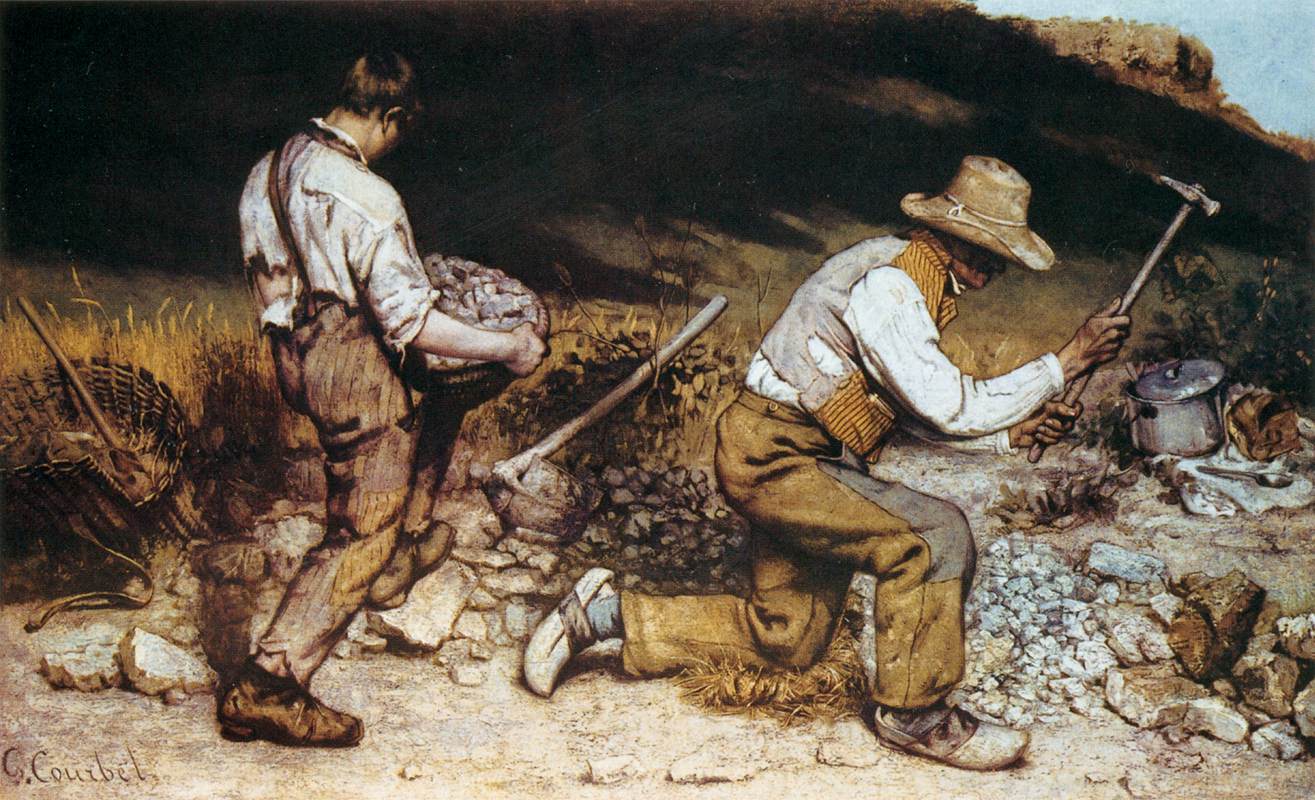
The influence of Realism's secular thrust carried throughout the 19th century, and is clearly evident in the work of both Manet and Monet. However, while Courbet, and his contemporary Daumier, principally focused on
Europe's working class, lending their works a socio-economic and critical disposition, �douard Manet, Monet and Renoir all favored lighthearted depictions of (secular) bourgeois outdoor
gatherings and fetes. In Camille Monet on a Garden Bench, Camille and her dandy admirer are clearly of the French bourgeoisie; they could have been plucked directly from La Musique aux Tuileries. Their situation in a
well-kept garden reflects a revived interest, common among the Impressionists and evident in their numerous landscapes specifically painted en plein air, in the Romantic pursuit of natural beauty and, perhaps, the translation of
the elusive sublime.
Conversely, Gauguin's The Siesta acknowledges, and radically rejects, the particular Impressionist concerns of subject, light, and color embodied by Camille Monet on a Garden Bench. A cursory glance of The Siesta
reveals a departure from those underlying principles, both visual and subjective, which provided an essential foundation for Monet and Impressionist art in general. Rather than represent Europe's alienated working class in the
Realist tradition of Courbet, or the lighthearted frivolousness of the Impressionists' favored bourgeoisie, Gauguin sought the unspoiled essence of peasant and primitive culture. His passion for emotional integrity, visually
expressed through the socially incorrupt, would help ignite a widespread revival of Primitivism in art.
By 1886, Gauguin had become disillusioned with the expansive influence of Western society. From his perspective, contemporary culture had promoted an aesthetic, in Realism and Impressionism, that was too imitative, too objective
in its compositional pursuits. For Gauguin, Realism and Impressionism lacked significant emotional and symbolic content, that feeling (later identified by Croce) which, through art, animated the objective image. A trip to
Brittany, during which he produced the masterpiece Jacob Wrestling with the Angel, emblematically released Gauguin from the theoretical and visual confines
of Impressionism. In Brittany's Catholic peasantry, Gauguin found subjects which embodied the emotional purity and virtuousness of communality that he sought to represent, far removed from the individualizing concerns of
industrial-commercial society. Seeking ever more provocative subjects and further isolation from the material trappings of bourgeois Europe, Gauguin pursued his tendencies and moved to the islands of Tahiti, opting to paint lush,
vivid landscapes infused with myriad exotic colors. The subtle, socially-critical aesthetic of Gauguin's paintings, which emphasized the virtuousness of nature and
the 'primitive' over the pleasantries of modern progress, indicates the strong influence of the French philosophe, Jean-Jacques Rousseau who, in his Discourse on the Moral Effects of the Arts and Sciences composed over a century
earlier, stated:
We cannot reflect on the morality of mankind without contemplating with pleasure the picture of the simplicity which prevailed in the earliest times. This image may be justly compared to a beautiful coast, adorned only by the hands of nature; towards which our eyes are constantly turned, and which we see receding with regret. While men were innocent and virtuous and loved to have the gods for witnesses of their actions, they dwelt together in the same huts; but when they became vicious, they grew tired of such inconvenient onlookers, and banished them to magnificent temples...As the conveniences of life increase, as the arts are brought to perfection, and luxury spreads, true courage flags, the virtues disappear; and all this is the effect of the sciences and of those acts which are exercised in the privacy of men's dwellings.
Both the subjective focus and the compositional mis-en-scence of The Siesta are clearly informed by Gauguin's Romantic-influenced aesthetic. The Siesta does not take place in a well-manicured European garden; its human foci are clearly not of the bourgeoisie. Several compositional elements suggest a deliberately non-bourgeois setting. The incorporation of vibrant, pastel (exotic) colors, the articulation of a wild, uncultivated environment expressed through flat patches (rather than points or strokes) of green and brown, the billowy, modest clothing of the four women represented and their deliberately bronze skin tone (compared to the facial pallor of Camille Monet), indicate, on the one hand, an interest in the representation of natural beauty and primitive virtue, and, on the other, a contempt for the haughtiness of European middle-class culture. The Siesta is situated in the far-removed, Romantic/exotic locale of the South Pacific, a distinct 'picture of the simplicity which prevailed in the earliest times.'
Gauguin's emphasis on emotional content, and his refutation of the Impressionist insistence on translating 'optical truth,' also determines his choice and application of color in The Siesta. Gauguin did not adhere to Realism's naturalistic use of local color, which demanded that objects be rendered in their genuine hue, nor did he subscribe to the Impressionist tendency to juxtapose complementary colors to create more vibrant or neutral tones. For Gauguin, color was a seminal element of artistic creativity, to be used, foremost, in an expressive capacity. In The Siesta, Gauguin asserts color, non-locally (the porch, rendered in pinkish tones was, in reality, probably not pink), as flat, unmodulated and autonomous planes. The repetition of patches of color, such as those fields of orange found in the background brush, in the Tahitian woman's chemise-like garment, and in the fruit peeking out of the foreground handbag, create a distinct compositional rhythm, a patterning of color-specific configurations which intensify the work's dreamy, lyrical and emotional content, and echo the formal designs found on the foreground subject's sarong. The Siesta's interest in compositional unity lent by aesthetic patterning, both through form and through color, presages the evolution of Fauvism, and those visual concerns later expressed by Henri Matisse in his masterpiece, The Dessert: Harmony in Red of 1909.
Moreover, in The Siesta, Gauguin rejects Monet's interpretations of contour, shadow and depth. This suggests a dissatisfaction with the aesthetic restrictions imposed by Impressionism's reliance on optical science. In Camille Monet on a Garden Bench, Monet deemphasizes the contours of his forms, shuns chiaroscuro, tinges his shadows with complementary colors and provides a horizon line which enables the viewer to approximate depth and distance. Gauguin, too, refutes chiaroscuro; shadows are expressed through single differentiations of tone rather than graduated shades. However, unlike Monet, whose expansive foreground shadow in Camille Monet on a Garden Bench lends weight to both Camille and the bench, Gauguin sparingly employs shading. His subjects lack sculptural definition and cast little or no shadow on the porch underfoot, advancing an impression of compositional weightlessness, ambiguous depth and free movement. This aesthetic discombobulation is further emphasized by Gauguin's lack of an establishing horizon line; expressions of genuine depth (while suggested by the porch's receding orthagonals) and optical honesty in The Siesta are suppressed in favor of compositional rhythm and the integrity of the (flat) picture plane. Furthermore, Gauguin outlines the forms of his subjects with an intentional black contour, a technique which would figure predominantly in the work of the German Expressionists, particularly Die Bruke artist Ernst Ludwig Kirchner. The incorporation of exaggerated limning drastically separates and flattens the shapes of Gauguin's Tahitian subjects, allowing them to function as both articulate, autonomous forms, and as part of the chiefly unmodulated, rhythmic patterning of the composition.
Having taken Gauguin's intentions and aesthetics under consideration, it becomes quite evident why a majority of critics describe his later work as 'Post-Impressionist,' that is, work that responds to, but is essentially distinct from, the 19th century Impressionism of Monet. Additionally, his works, like The Siesta, could also be considered 'Pre-Expressionist' in their liberal choice and application of vivid, non-local color, and their visual proximity to the later work of Matisse and Kirchner. 'Pre-Expressionist' would probably be a more precise term for Gauguin's emotion-laden, post-Brittany aesthetic, considering the 'Post-Impressionist' movement had no unified philosophical, compositional or doctrinal basis. Unfortunately, Gauguin's work, like a musical sharp or flat compressed between natural tones, is stuck in limbo between two domineering buoys of Western art, Impressionism and Expressionism, dependent on both to provide socio-historical context to his vibrant and liberated compositions. Exact definitions aside, a thorough analysis of the artistic elements constituting Monet's Camille Monet on a Garden Bench and Gauguin's The Siesta reveal both works to be representative of their 'movement's style,' Impressionism and Post-Impressionism (Pre-Expressionism), respectively.

